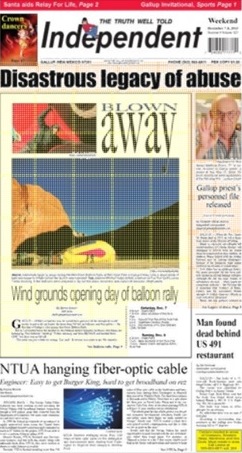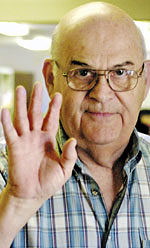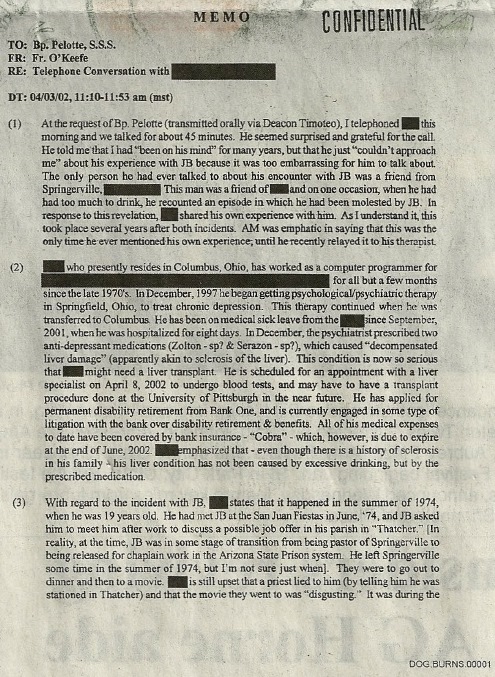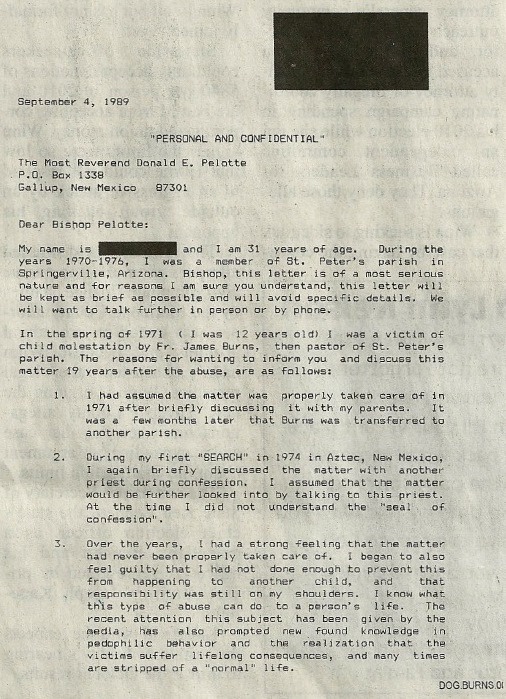Disastrous legacy of abuse By Elizabeth Hardin-Burrola [View the Burns file in searchable, easily downloaded form.] Burns, a convicted sex offender, left untold numbers of Catholic families still struggling to recover from the sexual abuse he perpetrated on their children. In addition, Burns helped push the Gallup Diocese into its current bankruptcy because of the numerous legal claims related to his decades of sexual abuse. Now Burns has an additional legacy: His priest personnel file has been publicly posted on several Internet websites. Although the file has huge chunks of information missing — many pages are completely redacted — the 564 page file is brimming with evidence of Burns’ crimes and the sometimes frantic attempts by Gallup chancery officials to cope with abuse allegations. Burns’ file was publicly released in October as part of the Archdiocese of Los Angeles’ 2007 settlement with hundreds of clergy sex abuse survivors. A decade ago the Gallup Diocese and the Los Angeles Archdiocese were named in a civil lawsuit by an Arizona man who said Burns sexually abused him as a teen in the 1980s, on trips to Los Angeles and in his hometown of Winslow, Ariz. The man also filed a police report with the Winslow Police Department, which resulted in prosecution by the Navajo County Attorney and a criminal conviction and brief prison stint for Burns.
Two law firms associated with Boucher, his own firm and Kiesel Law, have posted Burns’ personnel file on their websites. Now BishopAccountability.org, the vast online archive that documents clergy sex abuse, has recently posted Burns’ file on its searchable website. Burns’ file opens with a crime story: a two-page account of the priest’s alleged sexual assault of a 19-year-old Arizona man in 1974. Written April 3, 2002, as a memo by Gallup priest Larry O’Keefe to the late Bishop Donald E. Pelotte, O’Keefe relates the alleged victim’s story. According to the alleged victim, a former resident of St. Johns, Ariz., Burns invited the young man to dinner and a movie so they could discuss a job offer Burns had for the man at his Catholic parish in Thatcher, Ariz. Unfortunately, Burns was lying. Thatcher was actually in the Diocese of Tucson and Burns had no job to offer. Instead, the Gallup priest sexually assaulted the “shocked, intimidated and embarrassed” young man during a drive-in movie and afterwards unsuccessfully tried to talk the man into spending the night with him in a St. Johns’ motel room.
Twenty-eight years later, the man told O’Keefe he still had a “vivid memory” of the assault, he was receiving psychological therapy for chronic depression, and he was now facing a possible liver transplant because of damage caused by anti-depressant medications. He also told O’Keefe of another alleged Burns victim from Springerville, Ariz. (Burns file, pages 1-2). Evidence of more victims And for the next 564 pages, in spite of its heavy redactions, the Burns file provides evidence of more alleged victims either through hints in scrawled handwritten notes or documentation on official letterhead. Haphazardly organized, the file features huge chronological gaps. Although Burns, a Connecticut native, was assigned to numerous parishes across Northern Arizona, two New Mexico parishes and even a couple of Southern Arizona correctional facilities for the 31 years he worked as a priest, there are very few documents from the years Bishop Bernard Espelage and Bishop Jerome Hastrich were his supervising bishops. But in the year before Coadjutor Bishop Donald E. Pelotte took over the full reins of the diocese in March 1990, documented allegations against Burns piled up in the file. A handwritten note from Sept. 12, 1989, includes phrases “Had heard of problems at Pinetop” and “Motel young boy” (Burns file, page 110). An undated note, included with others from 1989, states, “Burns left Springerville went to prison work while in Pinetop he told L. O’Keefe, that inmate was accusing” and “Rumors he was moved out of Pinetop to Page for same reasons” (Burns file, pages 107-108). Most damning The most damning allegation, however, came in the form of a neatly typed letter by a former parishioner of St. Peter’s Parish in Springerville, Ariz. In his letter of Sept. 4, 1989, the man says he was sexually molested as a 12-year-old boy by Burns in 1971, and he had shared this information with O’Keefe a few years later during confession (Burns file, pages 113-114).
A flurry of chancery documents, mostly undated and unsigned, discuss this man’s allegation — described as a “hot potato” — and what the man might do and who he might tell. How the Gallup Diocese responded to the letter writer, who apparently had several more conversations about the molestation with O’Keefe through the years, is not documented in the file. Nor, apparently, was the allegation ever reported to law enforcement (Burns file, pages 108-109, [and] 125-127). By January 1990, Burns was in trouble at St. Joseph’s Parish in Winslow. Many of his parishioners, along the Rev. John Forman, an assistant pastor, were alleging Burns had embezzled money from the church. In addition, another assistant pastor, the Rev. Timothy Farrell, had apparently reported Burns to chancery officials for alleged sexual misconduct. In a typewritten note to Pelotte written later that year, Brother Duane Torisky, O.F.M., then the diocesan chancellor, recalled “what Farrel (sic) saw at 3AM in the morning with the parade of folks in/out of the rectory and coming in/out of Jim’s suite” and that “Forman had made xerox copies of financial records that he now claims could prove damaging to Burns’ reputation” and that Forman “might publish these reports in that weekly rag they publish in Winslow.” (Burns file, pages 151[, and] 152-]153, [and] 183). Shopping for a solution By March 20, 1990, Pelotte had become bishop and was shopping for a solution to the thorny problem of James Burns. Pelotte contacted at least one other Catholic facility, the Saint Luke Institute in Maryland, before settling on a New Mexico facility run by the Servants of the Paraclete in Jemez Springs. Now closed down, the facility has become infamous for its treatment of many notorious pedophile priests from across the United States. But in the spring of 1990, not many outsiders were aware of who was living behind the facility’s walls in scenic Jemez Springs. In six months time, with some art therapy, psychodrama and sexuality group training under his belt, Burns would be refreshed and ready for another pastoral assignment in the Diocese of Gallup. Editor’s Note: Monday, Part 2 of this series will look at the documents concerning Burns’ treatment at Jemez Springs, his return to the Gallup Diocese, and the final allegation that removed him from ministry. [Note from BishopAccountability.org: The Burns file is Bates numbered to page 564, but nine pages are missing from the file as it was released. See our note.]
|
.
Any original material on these pages is copyright © BishopAccountability.org 2004. Reproduce freely with attribution.



